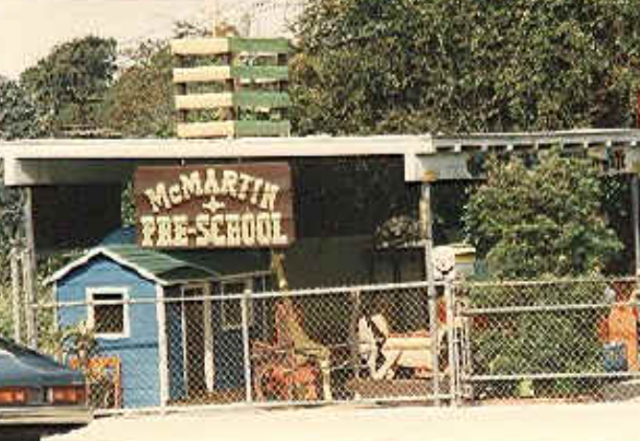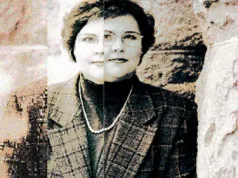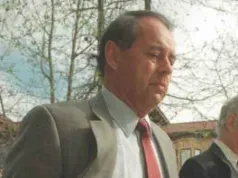The McMartin Preschool abuse trial is one of the most notorious cases in the history of law, psychiatry, and general events of the 1980s.
It came at a time where there was mass hysteria in the United States revolving around allegations of sexual abuse and satanic ritual abuse in day care centres.
The McMartin case would go on to become the longest running and most expensive in American history – yet ended in no convictions. In this article, we review the event.
Origins and Accusations
In 1983, Judy Johnson – who was a mother of a 2-year old trial at the McMartin Preschool in California – told the Police that one of the employees at the school had molested her child.
The employee who allegedly committed the act was Ray Buckey. Immediately there were questions raised, as the child couldn’t identify Buckey from some photos, and the child showed no signs of being the victim of abuse. Despite this, the Police launched into action, searching Buckley’s house, and confiscated a number of items. He was soon arrested.
The day after, Police Chief Harry Kuhlmeyer sent a letter to the parents of children who had attended the preschool – which totalled approximately 200 students.
In the letter, the parents were told that Buckey had been arrested on suspicion of child abuse. The Police appealed for more information from the parents, and to check if their child had been abused, or witnessed anything untoward.
The letter suggested that actions committed may have included “oral sex, fondling of genitals, buttock or chest area and sodomy”. The letter asked parents to not talk about the accusations beyond immediate family members.
But as anyone could have predicted, the news spread like wildfire around the entire state of California, and soon enough came to the attention of the national press.
Judy Johnson – the parent who had started the entire case off, continued her accusations in the following days. These accusations were focused on Ray’s mother Peggy – who also worked at the pre-school.
She accused Peggy Buckey of being involved in satanic abuse; this involved Johnson’s child being forced to witness a baby being decapitated, and then being forced to drink the blood of the infant.
Moreover, Judy went on to state that Ray Buckey had locked her son in a car boot, among other bizarre allegations.
Investigations into the pre-school
Based on these latest accusations, Police chief Kuhlmeyer wrote again to parents, asking for further information, and updating them on the latest accusations.
This prompted fury from parents, who at this point were baying for blood. The parents demanded a wide-scale investigation into the preschool was launched. The Police soon referred the case to the Children’s Institute International (CII) – an agency that helped prevent and treat abused children.
The CII asked parents to allow their children to partake in one-on-one, two-hour interviews. The interviews were carried out by CII consultant Kathleen MacFarlane.
MacFarlane used a roleplay format with the children to try and ascertain whether or not they had been abused. Interview transcripts showed that MacFarlane’s questions were highly suggestive, and practically guided a child towards agreeing with her hypothesis.
In some cases, it appeared as if the children were being incentivised to agree with the allegations. Interview transcripts also pointed to the suggestion that MacFarlane shaped questions in a way to fit her own narrative.
In total, 400 children were interviewed, including some past pupils. While most children denied being the victim of or seeing any abuse at first, some relented to MacFarlane’s questioning. MacFarlane concluded that 384 of the 400 children interviewed had been sexually abused. She notified parents.
Around half of those diagnosed partook in a medical exam, with the diagnosis backed up by Dr. Astrid Heger, who stated 80% of those she examined had been molested. Heger worked for the CII, the same organisation as MacFarlane. Heger didn’t use physical signs as evidence, but instead relied on her belief that ‘any conclusion should validate the child’s history’.
Possibility of “secret rooms”
Parents had also spoken of “secret rooms” where sexual abuse was carried out – but again nothing was found.
Not satisfied with this result, the parents of the children organised for a mass search for the ‘secret rooms’.
They dug up a lot of ground next to the preschool, and also enlisted the help of an archaeological company. However, nothing was found.
Arrests
Meanwhile, the Police were also investigating the preschool. They were especially looking for photos – with parents of children speaking of pictures often being taken. But nothing incriminating was found, with photos meeting usual expectations.
The Police quickly arrested seven people. Four of the seven were members of the McMartin family. Peggy, her daughter Peggy Junior, Ray, and the founder of the preschool – Virginia McMartin, were arrested.
Three others, who were teachers at the preschool were also arrested. These were Mary Ann Jackson, Babette Spitler and Bette Raidor.
The ‘McMartin Seven’ were indicted on 115 counts of child sexual abuse. A further 93 counts followed – at the behest of District Attorney Robert Philobosian, who was hoping to use the case to improve his chances of winning an upcoming election.
Preliminary Hearing
All seven appeared at a Preliminary Hearing, where Lael Rubin – the chief of three prosecutors – stated the seven had committed a total of 397 sexual abuses, which was much higher than their indictment suggested.
But the Preliminary Hearing lasted much longer than usual, owing to the fact that each of the McMartin Seven had their own lawyer.
Prosecution witnesses were called during the preliminary hearing – another rarity. This was due to defence attorneys clubbing together to launch an affirmative defence. Professionals, parents and even some children were probed by an array of lawyers.
The main argument of the defence was that such widescale abuse could not have gone unnoticed for the length of time it supposedly did.
Katherine MacFarlane was called to testify. When questioned how the abuse could have lasted for years without anyone noticing, she suggested the children may have had “denial syndrome”, or that they feared for their lives if they spoke out. She talked through her methods of eliciting answers from the children.
Videotapes shown were attacked by the defence, who stated that they clearly demonstrated MacFarlane’s leading questions and pressure on the children to respond with answers.
Moreover, they also showed a video that depicted another therapist saying to a child that their teachers were “sick in the head”, and that their peers had already revealed “yucky secrets” about the staff. The defence suggested that this was a sign that the children had been pushed towards talking about alleged abuse.
When children were interviewed, there were marked inconsistencies within their testimonies. Some of their recollections were bizarre, and featured tales of games, songs and dances involving abuse.
There were suggestions that the abuse happened in many different locations, not limited to the preschool. A secret room was again named a place where abuse was carried out.
One child even spoke of witnessing an animal sacrifice ceremony performed by preschool staff. Another suggested the children were taken to a cemetery and told to dig up coffins; when this was complete, the teachers reputedly started stabbing the bodies. Many speculated that the children’s state of mind represented that of someone with what is known as False Memory Syndrome.
All of this took place over several months, and eventually led to some members of the prosecution believing that the abuse may not have happened.
A meeting held at the District Attorney’s office led to five of the seven defendants seeing their charges dropped.
This left just Ray and Peggy, the son and mother duo that had first been accused of the abuse. By the end of 1985 – over two years since the first accusations were made – just two people would advance to the full trial.
Controversial voice clip discovery
Before the trial began, a key moment in the overall case happened, with a voice recording throwing further doubt onto the veracity of the claims in the case.
A group of documentary-makers discovered an interview with one of the prosecutors – Glenn Stevens. In this interview, Stevens told of how the children were “embellishing” their accounts of sexual abuse.
Furthermore, Stevens went on to state that prosecutors “had no business being in court”. Worse yet, Stevens stated how the prosecutors had withheld crucial information from the defence – including the fact that Judy Johnson’s child couldn’t identify Ray Buckey, and that Judy herself was seen as mentally unstable.
Based on this information, defence lawyers requested all charges were to be dropped. However, the Judge denied this. This meant the case would continue. Jury selection took over a month, before the trial finally started. Both Ray and Peggy had been in jail during this time.
The Trial
As seen in the preliminary hearing, the prosecution relied on the testimony of parents and their children to demonstrate the abuse, while the defence focused on trying to prove that the techniques used to interview children led to baseless allegations.
The defence spoke about how the preschool had operated for two decades without any problems, and that despite widespread searching, nothing incriminating was found at the preschool.
Opening statements were heard in July 1987 – a full four years after the initial allegations were made. Over the course of the following months, dozens of witnesses were called to testify.
The prosecution presented a total of 61 witnesses. Just 9 children were among these witnesses. Parents were mainly used for the prosecution, and spoke of how nightmares and illnesses led to their suspicions – albeit after the original letter from Police chief Kuhlmeyer had arrived, as well as the interview with MacFarlane.
The nine children who testified repeated similar stories from the preliminary hearing – again speaking of games, dances and songs that involved molestation.
There was also an account of Ray allegedly executing a cat in a bid to scare the children. The defence picked apart the children’s stories, and showed the jury how MacFarlane’s questioning techniques seemed to influence the children, who had gone from denying the abuse to agreeing with the picture being painted by MacFarlane.
MacFarlane was one of the 61 witnesses, and spent a gruelling five weeks on the stand. MacFarlane defended her techniques while on the witness stand.
The defence called upon Dr. Michael Maloney – a psychiatrist, to criticise the techniques used, suggesting that the technique resembled a script being used, with children left to fill in a limited space, essentially conforming to MacFarlane’s suggestions. He described the interviews as “coercive and improper”.
Another witness – a jailhouse informant named George Freeman – was used on the basis of an alleged ‘confession’ by Ray Buckey in jail.
The two were in jail together, when Ray ostensibly stated that he had molested the children, and even had an incestuous relationship with his sister Peggy Junior.
The defence brought up George’s record of perjury and long history of crimes as a way of attempting to discredit this testimony – along with the fact that he had been incentivised to give testimony with the chance to be given immunity from other charges to testify.
The main portion of the trial involved the defendants providing testimony. Peggy told the jury she had never molested children, and suggested her son Ray hadn’t ever behaved in a sexually inappropriate way at the preschool. Ray also denied all allegations, including that of the jail informant Freeman’s testimony.
The trial was an incredibly long affair. After two and a half years of hearing testimonies, the defence rested, leading to the end of the trial.
The jury were sent to reach their verdict. The jury took almost ten weeks to reach a decision. Peggy was acquitted of all charges, but the jury were deadlocked in their decision on Ray Buckey, leading to a mistrial being declared.
In a press conference following the trial, jury members stated that they did believe that children had been molested, but that the evidence provided led to them being unable to decide whom had committed the abuse, beyond a reasonable doubt.
Most of the jurors sided with Ray’s acquittal, but a unanimous verdict couldn’t be reached, leading to a hung jury, and the aforementioned mistrial. Ray was released on bail.
The retrial
Following the original decision, a group of almost 1,000 people marched near the preschool to demand a retrial.
A second trial was indeed granted, with a new judge put in place, as well as two new prosecutors. Only Ray Buckey remained on trial, now charged with 8 counts of sexual abuse.
The trial was much quicker, with the prosecution only using eleven witnesses. Again, children and parents were used. They decided not to call MacFarlane to the stand, but the defence called her anyway.
The same arguments used in the first trial were repeated again – with a new jury installed. This time, the trial lasted three months, with the jury asked to reach a verdict.
But the jury were deadlocked on each of the 8 counts. A mistrial was declared, and the charges against Buckey were dismissed after the District Attorney’s office declined to not try Buckey for a third time.
Finally, in 1990, seven years after the entire investigation began, the case ended. It ended too in a rather anticlimactic way, with no definitive decision made.
Embed from Getty ImagesThe Infamy
The McMartin preschool abuse case is renowned for many reasons – mostly negative. There were no winners in this case, if truth be told.
Ray Buckey spent five years in jail for a crime he didn’t seemingly commit. He and the rest of the original defendants had a stigma attached to them, and had lost their jobs. The Buckey family criticised the parents for causing the case.
The woman whose call started the entire event – Judy Johnson, was believed to have suffered from Schizophrenia. She passed away before the first trial started.
The careers of the prosecutors were left in tatters. The parents were left with a sense that justice hadn’t been served. Many criticised the parents’ role in the case, with many suggesting it resembled a modern-day witch hunt. Kathleen MacFarlane was also heavily criticised.
The children however were arguably the biggest losers in the case. They were dragged through a process that no child should go through. While it isn’t clear if the abuse did take place, it was a very graphic and harrowing case.
This case was far from isolated, with accusations of abuse in preschools being common in the 1980s and 1990s. This coincided with a surge in reported cases of recovered memories, which led to numerous trials. The McMartin case also led to changes in preschools – with staff more careful with their interactions with children.
In more recent years, several people that were children at the preschool at the time have come forward stating that no abuse happened, and that they had lied after being pressed for the “correct” answers by questioners. But still, many believe that abuse did happen at the preschool, and that such abuse was covered up.
So, after seven years of hard work, a $15million war-chest spent and emotionally damaged children – there were no convictions.
Sadly, the McMartin preschool trial is now best-known as a mere case study for how some cases can get out of control, and its record of length and expenditure.
Summary
Memory has proven to be a controversial concept, as numerous cases have shown. There is surely no clearer example of this than the McMartin case.
The McMartin preschool closed in the aftermath of the trial, and the building was demolished. Questions will always remain with this case, with no definitive answers ever given.
VISIT OUR RECOVERED MEMORY BLOG
Disclaimer
This website should be used purely for informational purposes, and does not intend to, nor should it ever, be used as a replacement for professional medical advice.
We strive to keep all of our pages updated, and ensure that our website is full of factual and in-depth information. However, we encourage you to browse this website with care.
As a reminder, this website and all content within it cannot and should not replace the advice of a trained medical professional. You can read our full disclaimer at this link.
Helplines
If you are struggling with your mental health, help is available. With the right support and treatment, you can make a recovery. For information on helplines, or if you are in a state of crisis, please visit our crisis page by clicking on the relevant link for your geographical location (United Kingdom), (United States), (International). You can also see how to get mental health treatment and the process involved by clicking this link.

































